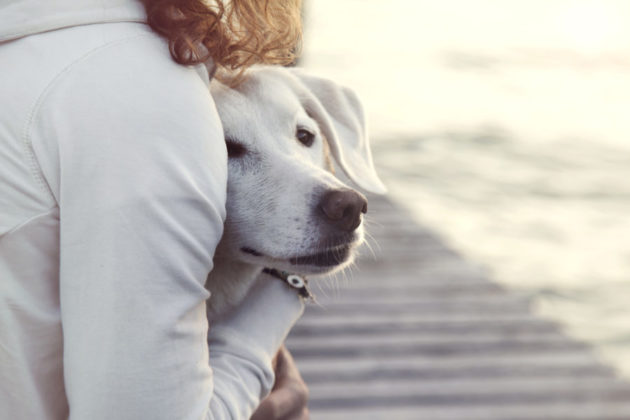Alleviate your dog’s fear based behaviours stemming from poor socialization, abuse, traumatic events and even genetics.
Joe and Melissa adopted a young mixed breed from a rescue group. Shilo was found as a stray, so no one knows her early history. But her new family is convinced she must have suffered some abuse, because she is anxious, skittish and reacts with fear to many harmless events. She crouches in fear if she is too close to a door when someone opens it, and hides under the coffee table in response to loud noises from the television. she also submissively urinates when meeting new people, and cringes when Joe or Melissa bend down to clip her leash on.
Potential causes
While abuse could certainly account for Shilo’s fearful behavior, it’s not the only possibility. Because Joe and Melissa don’t have a documented history of her past, and she shows no signs of physical trauma, there are no reliable behavioral criteria to distinguish abusive treatment from several other explanations for shill’s behaviours.
Focus on the present, not the past
The best way to help dogs we think may have been abused – or any dog showing fear and avoidance behaviors – is to be less concerned about attaching labels to these dogs and to why they are fearful. we don’t have the luxury of a “do over”. We can’t go back in time and give the dog a better early life or “undo” the traumatic or frightening experiences.
Instead, our best bet is to be extremely observant and learn to recognize even subtle signs of fear and anxiety, while at the same time identify the specific environmental events that trigger these reactions. Doing so is the first step in creating effective behavior modification plans, and will be much more helpful than worrying about past events. Here are five steps we believe are the best ways to help any fearful dog.
1. Have realistic expectations
Very fearful dogs may never be “normal”. while many fearful or abused dogs recover or improve with time and/or specific treatments, don’t expect them to turn into “social butterflies” or become confident and outgoing in all situations. Research shows that dogs acquired from puppy mills, for example, can never be reliably housetrained after spending most of their lives in cages. Dogs that have experienced a particularly traumatic event, were poorly socialized and/or had limited experiences when young, and those born with genetic predispositions to fearfulness, may never behave like other dogs. If you have a fearful dog, accept the fact that even your best efforts may not make him “normal”.
2. Manage the environment to minimize exposure to frightening situations
Repeated exposure to feared conditions maintains the fear, and more importantly, interferes with behavior modifi cation procedures for reducing fearful reactions. Continually forcing a dog to be around people, sounds or events that bring out a full intensity fear response will not help him “get over” it. In fact, if a fearful animal can’t avoid or escape frightening situations, aggression can result. If a dog is afraid of so many things that there’s really no conditions in which he can relax and be at ease, then some sort of medication or other remedies may be needed.
3. Provide a healthy lifestyle
A good diet, proper veterinary care, exercise and mental stimulation can help any dog deal with the challenges of life. Good health will help a fearful or traumatized dog cope with stress. Play and exercise release tension, help the dog relax, provide a sense of control, and improve quality of life.
4. Use behavior modification techniques to reduce reactions to fearful things
Behaviour modification techniques known as desensitization and counter conditioning have an excellent track record in the treatment of all sorts of fears, phobias and anxiety disorders. These procedures involve gradual, controlled exposures to fear-eliciting stimuli, in order to change the emotional state. If a previously feared stimulus becomes the signal for something wonderful, the dog’s reaction will change. When emotional states change, it becomes much easier to also change voluntary behaviors. This approach, when done correctly, can be very successful in reducing both fearful emotions and behaviors. You may need the help of an experienced and certified behaviorist or behavior consultant to implement this kind of plan. Attempting these procedures and doing them incorrectly can make the problem worse.
5. Talk to your veterinarian about medication and investigate natural remedies
If your dog is fearful most of the time, or if environmental management and behavior modification techniques don’t seem to be helping, talk to your veterinarian about additional options. He or she can prescribe anti-anxiety medications that can help temporarily reduce fear so that behavior modifi cation can be successful.
Holistic veterinarians can prescribe specifi c remedies or dietary supplements, often combined with acupuncture and massage. Pheromones may help dogs feel more relaxed, and products such as thunderstorm wraps can help keep them calmer in the face of anxiety-producing situations.
Regardless of what has caused your dog to become fearful, these treatments will help. The sooner you recognize fearful and anxious states in your dog, and identify the situations that trigger them, the more effective treatment will be.
Potential causes to fear
In our experience, the most likely cause of fear-based behavior is that the dog was not well socialized. Dogs that aren’t exposed at a young age to a variety of people and environments, and to the daily activities of a typical household, often react fearfully because these events are completely novel and unexpected. Well socialized dogs can readily adjust to changes, but those that were isolated or neglected during puppyhood have difficulty adapting to anything new and different.
A second possibility is that the dog possesses an inherently shy temperament. Data from guide dog breeding programs from as far back as the 1960s shows that fearful puppies tend to become fearful adults, indicating that genetic factors may have a strong influence. Of course, all behaviors result from interactions between genetics and experience, so these first two possibilities are not mutually exclusive.
Military working dogs and those that survive natural disasters such as hurricanes, wildfires or earthquakes are said to suffer from PTSD. (post-traumatic stress disorder) Symptoms of canine PTSD are said to be hyper-vigilance, aggression, increased timidity, unwillingness to go places they once felt comfortable, and/or not performing tasks they were previously trained to do.
It may be simpler – and in the long run more helpful — to view these symptoms as conditioned fear responses in which previously neutral sights or sounds now predict something bad. This is often the result of conditioned fears. The sound of wind or rain may cause fear because they “predict” a hurricane; to a dog that’s been through a wildfire, the smell of smoke from the barbeque can cause anxiety. Dogs afraid of thunder often show fear of other cues that predict a storm is coming. Harsh or confrontational training techniques that involve physical punishment can produce conditioned fears to any event (such has having a leash put on)

